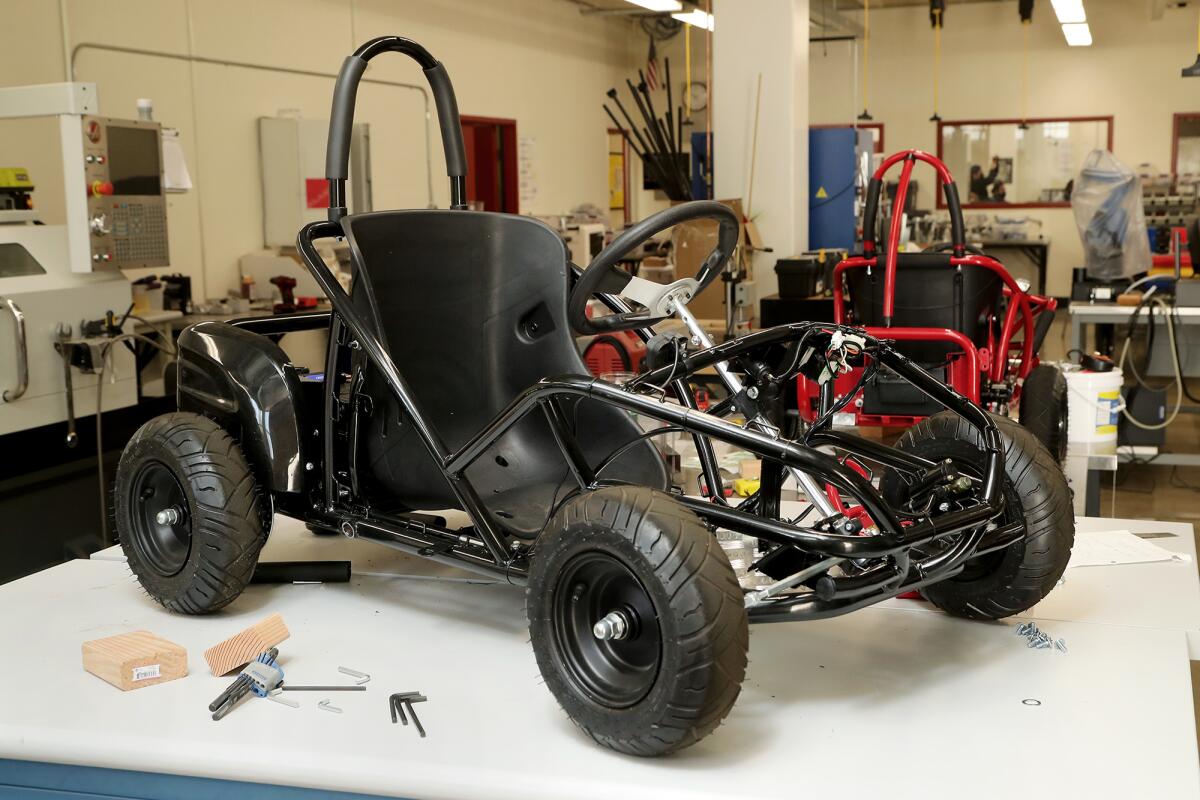Estancia High engineering team builds a better car, wins Energy Invitational

- Share via
Estancia High School engineering students were recently tasked with designing and building a vehicle large enough to accommodate a driver that would travel as fast and as far as possible on only $1 worth of energy.
In record time, 16 seniors participating in their first 2021 Vital Link Energy Invitational Engineering Design Competition — working together as “Team Havoc,” — had retrofitted a simple go-kart into an electric car that based on initial testing is capable of reaching speeds up to 30 mph while using only 1.0 kilowatt-hour for more than an hour of continuous driving.
“We took a preexisting machine and configured it so it would meet our specifications,” said project manager Carter Gruebel, 18. “Then, we designed modifications, such as an external frame, buying a new motor battery system and making our brakes and tires more efficient.”
That result earned them 47 points out of a possible 48 and last week landed the team a first-place win over competitors from schools in Huntington Beach, Tustin, Long Beach and Hacienda Heights, known for well-established STEM programs and engineering academies.

Gerald Rizza, an engineering design teacher for Estancia and Team Havoc’s adviser, explained the competition was a capstone project for seniors enrolled in the school’s Project Lead the Way career pathway.
“We probably had less than three months from the day we said, ‘OK, we’re going to do this’ to the day we had to deliver,” Rizza said of the March 19 deadline that required kids to submit a completed design report, a presentation of their effort and a video showcasing the finished product.
“It was a coordinated nightmare,” he joked. “But they all made it happen.”
In addition to the many challenges posed by the competition guidelines, Estancia students also worked through enormous logistical complications presented by the pandemic, including soliciting donations to cover the $3,400 project cost.
Coming onto campus in separate cohorts, team members worked in shifts, some doing hands-on work while others chimed in virtually through Zoom. As project manager, Gruebel had to supervise both sets of students.
“At first, it was kind of hard to coordinate what each cohort was doing,” he said. “But we ended up adding a daily progress report to write down what each cohort did and what we wanted the next cohort to accomplish.”
Senior Nathan Sweet, the team’s media lead, documented the process from start to finish for the requisite design video. Unanticipated setbacks, like camera drone crash, software malfunction and spending five hours editing a three-minute video, imparted some valuable life lessons.
“One of the biggest things I learned is that you really need to be prepared for the worst,” Sweet said. “But while being prepared for the worst, stay positive. Also, making backups is extremely helpful.”
Teammate Nathan Flores, who oversaw safety compliance, had never worked on a project as complex and multifaceted as the Invitational. It was a real learning experience.
“I was kind of used to these small projects these last few years, but this was the first big project,” said the 17-year-old engineer. “Anytime I was stuck on any research problems, any calculation problems, I had to ask my teammates for help — that teamwork was especially helpful.”
Started in 1998 by Michael McCarthy, a mechanical and aerospace engineering professor at UC Irvine, the Energy Invitational began as a college competition but later expanded to include high school entrants.
While the annual competition traditionally pits teams against one another in aspects of design and on-the-ground performance demonstrations, a lingering pandemic precluded the latter, making the presentation element especially critical.
To help balance the workload the class split into subgroups, each responsible for a different aspect of the project — motor, brake system, frame, wheels, compliance, safety, quality surveillance, etc.
Senior Ryan Ray, who plans to study mechanical engineering at Embry-Riddle Aeronautical University, was pleased with how the team’s vehicle performed, even though it was never pit against the competition.
“Since we actually never got to race the vehicle, we can only theorize,” Ray said.
But, still, Team Havoc will accept the win and the suite of engineering software that comes with it.
“I challenged the class not to go for gold, but titanium,” Rizza said. “Was it rocky at first? You bet it was. But they really performed so, so well. I’m very impressed.”
All the latest on Orange County from Orange County.
Get our free TimesOC newsletter.
You may occasionally receive promotional content from the Daily Pilot.







